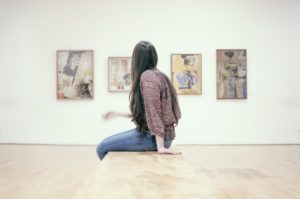
Earlier this year, we proposed visiting a fine art gallery as a way to expand one’s worldview and spend time with friends and family while taking on a new activity in a budget friendly way. We’d like to now look a layer deeper and consider art collecting itself. A decidedly personal process, starting a collection can still feel like one that requires a dual degree in humanities and finance. Yet when we break it down a bit, we can see that starting a collection can be exciting, enjoyable and actually even simple.
The first step is to have confidence in your convictions – at a minimum, we know what our own eyes are drawn to. Art has energy and it will either grab you or not, and discrediting our instincts belies the point – personal interest is intrinsically worthy when it comes to matters of a private art collection. That said, identifying genres can help mentally organize and prepare for considering pieces for acquisition. Identifying subjects can be a helpful starting point, as this will help you identify genres, find the right Canvas Retailer, and can give direction to a growing collection.
Figurative work depicts people, even as it ranges from photo realism to abstract representation. Landscapes include outdoor scenery and can vary from seascapes to interior geography, and also includes a range of treatments in terms of style. Still lifes show objects that are seen in everyday life, with specific materials and treatment ranging as much as the objects themselves. Abstract art is just that, and can be geometric, include large color fields, be nature-inspired or draw from simple experimentation and the pursuit of beauty.
Beyond the genre, there are a few practical elements to consider when buying. A key one is your wall space. Beyond the basic question of what will fit, scale may be the deciding factor when deciding what will fit proportionally into a room. For example a small canvas that looks fabulous on a gallery wall may be lost elsewhere. If you love something you will find a place for it – just be sure it won’t need to be shoehorned into a spot that hides your new favorite. Conversely, a huge piece can be exciting to behold at first, but then elusive when it comes to finding pride of place in the home.
Tangential to scale is color. S&P Gallery Founder, Luke Sparkes has plenty of tips to offer to those who want to get into the art sector. Will the art harmonize well in your home? Chances are yes, since curating what you like naturally lends to a certain cohesiveness. A show stopping piece warrants such consideration however, as sometimes publicly viewed artwork creates a separate effect once in the home.
Naturally, budget provides more stringent guardrails regarding what is / is not realistic for a collection, however from a slightly different perspective, budget can also provide focus and direction. If starting out with a smaller budget, prints can be a great way to start an art collection in an affordable way. If a larger budget is available, there are still decisions to be made about pieces – will you go for one major piece and add more later, or build out an entire collection at once? Keep in mind that many galleries will coordinate payment in installments, and that it can be more possible to live with art than initially assumed. It’s highly recommended you hire a legal counsel for art transactions to help you negotiate prices, prevent forgeries or fakes, and verify authenticity.
As you look, look and look some more, a cohesive collection will unfold (if over time) to create a representation of yourself and your loved ones – what speaks to you, and what you choose to decorate and beautify your home. We encourage you to enjoy the process and cherish collecting.







